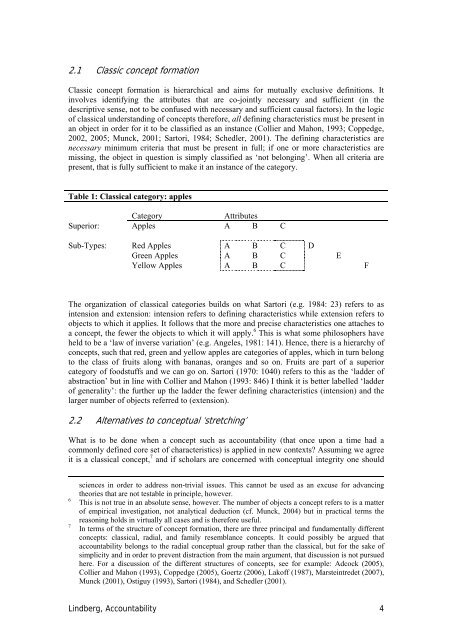Accountability
Accountability
Accountability
Create successful ePaper yourself
Turn your PDF publications into a flip-book with our unique Google optimized e-Paper software.
2.1 Classic concept formation<br />
Classic concept formation is hierarchical and aims for mutually exclusive definitions. It<br />
involves identifying the attributes that are co-jointly necessary and sufficient (in the<br />
descriptive sense, not to be confused with necessary and sufficient causal factors). In the logic<br />
of classical understanding of concepts therefore, all defining characteristics must be present in<br />
an object in order for it to be classified as an instance (Collier and Mahon, 1993; Coppedge,<br />
2002, 2005; Munck, 2001; Sartori, 1984; Schedler, 2001). The defining characteristics are<br />
necessary minimum criteria that must be present in full; if one or more characteristics are<br />
missing, the object in question is simply classified as ‘not belonging’. When all criteria are<br />
present, that is fully sufficient to make it an instance of the category.<br />
Table 1: Classical category: apples<br />
Category<br />
Attributes<br />
Superior: Apples A B C<br />
Sub-Types: Red Apples A B C D<br />
Green Apples A B C E<br />
Yellow Apples A B C F<br />
The organization of classical categories builds on what Sartori (e.g. 1984: 23) refers to as<br />
intension and extension: intension refers to defining characteristics while extension refers to<br />
objects to which it applies. It follows that the more and precise characteristics one attaches to<br />
a concept, the fewer the objects to which it will apply. 6 This is what some philosophers have<br />
held to be a ‘law of inverse variation’ (e.g. Angeles, 1981: 141). Hence, there is a hierarchy of<br />
concepts, such that red, green and yellow apples are categories of apples, which in turn belong<br />
to the class of fruits along with bananas, oranges and so on. Fruits are part of a superior<br />
category of foodstuffs and we can go on. Sartori (1970: 1040) refers to this as the ‘ladder of<br />
abstraction’ but in line with Collier and Mahon (1993: 846) I think it is better labelled ‘ladder<br />
of generality’: the further up the ladder the fewer defining characteristics (intension) and the<br />
larger number of objects referred to (extension).<br />
2.2 Alternatives to conceptual ‘stretching’<br />
What is to be done when a concept such as accountability (that once upon a time had a<br />
commonly defined core set of characteristics) is applied in new contexts? Assuming we agree<br />
it is a classical concept, 7 and if scholars are concerned with conceptual integrity one should<br />
6<br />
7<br />
sciences in order to address non-trivial issues. This cannot be used as an excuse for advancing<br />
theories that are not testable in principle, however.<br />
This is not true in an absolute sense, however. The number of objects a concept refers to is a matter<br />
of empirical investigation, not analytical deduction (cf. Munck, 2004) but in practical terms the<br />
reasoning holds in virtually all cases and is therefore useful.<br />
In terms of the structure of concept formation, there are three principal and fundamentally different<br />
concepts: classical, radial, and family resemblance concepts. It could possibly be argued that<br />
accountability belongs to the radial conceptual group rather than the classical, but for the sake of<br />
simplicity and in order to prevent distraction from the main argument, that discussion is not pursued<br />
here. For a discussion of the different structures of concepts, see for example: Adcock (2005),<br />
Collier and Mahon (1993), Coppedge (2005), Goertz (2006), Lakoff (1987), Marsteintredet (2007),<br />
Munck (2001), Ostiguy (1993), Sartori (1984), and Schedler (2001).<br />
Lindberg, <strong>Accountability</strong> 4

















